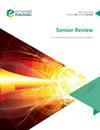Toward chipless RFID sensor for metal surface cracks detection
IF 1.6
4区 工程技术
Q3 INSTRUMENTS & INSTRUMENTATION
引用次数: 0
Abstract
Purpose Passive chipless RFID (radio frequency identification) sensors, devoid of batteries or wires for data transmission to a signal reader, demonstrate stability in severe conditions. Consequently, employing these sensors for metal crack detection ensures ease of deployment, longevity and reusability. This study aims to introduce a chipless RFID sensor design tailored for detecting metal cracks, emphasizing tag reusability and prolonged service life. Design/methodology/approach The passive RFID sensor is affixed to the surface of the aluminum plate under examination, positioned over the metal cracks. These cracks alter the electrical length of the sensor, thereby influencing its amplitude-frequency characteristics. Hence, the amplitude-frequency profile generated by various metal cracks can effectively ascertain the occurrence and orientation of the cracks. Findings Simulation and experimental results show that the proposed crack sensing tag produces different frequency amplitude changes for four directions of cracks and can recognize the crack direction. The sensor has a small size and simple structure, which makes it easy to deploy. Originality/value This research aims to deploy crack detection on metallic surfaces using passive chipless RFID sensors, analyze the amplitude-frequency characteristics of crack formation and distinguish cracks of varying widths and orientations. The designed sensor boasts a straightforward structural design, facilitating ease of deployment, and offers a degree of reusability.开发用于金属表面裂缝检测的无芯片 RFID 传感器
目的无源无芯片 RFID(射频识别)传感器没有电池或用于向信号读取器传输数据的电线,在恶劣条件下也能保持稳定。因此,使用这些传感器进行金属裂纹检测,可确保其易于部署、使用寿命长且可重复使用。本研究旨在介绍一种专为检测金属裂缝而设计的无芯片 RFID 传感器,强调标签的可重复使用性和延长使用寿命。这些裂缝会改变传感器的电气长度,从而影响其振幅-频率特性。模拟和实验结果表明,所提出的裂纹传感标签能对四个方向的裂纹产生不同的频率振幅变化,并能识别裂纹方向。本研究旨在利用无源无芯片 RFID 传感器对金属表面进行裂纹检测,分析裂纹形成的幅频特性,并区分不同宽度和方向的裂纹。所设计的传感器结构设计简单明了,便于部署,并具有一定的重复使用性。
本文章由计算机程序翻译,如有差异,请以英文原文为准。
求助全文
约1分钟内获得全文
求助全文
来源期刊

Sensor Review
工程技术-仪器仪表
CiteScore
3.40
自引率
6.20%
发文量
50
审稿时长
3.7 months
期刊介绍:
Sensor Review publishes peer reviewed state-of-the-art articles and specially commissioned technology reviews. Each issue of this multidisciplinary journal includes high quality original content covering all aspects of sensors and their applications, and reflecting the most interesting and strategically important research and development activities from around the world. Because of this, readers can stay at the very forefront of high technology sensor developments.
Emphasis is placed on detailed independent regular and review articles identifying the full range of sensors currently available for specific applications, as well as highlighting those areas of technology showing great potential for the future. The journal encourages authors to consider the practical and social implications of their articles.
All articles undergo a rigorous double-blind peer review process which involves an initial assessment of suitability of an article for the journal followed by sending it to, at least two reviewers in the field if deemed suitable.
Sensor Review’s coverage includes, but is not restricted to:
Mechanical sensors – position, displacement, proximity, velocity, acceleration, vibration, force, torque, pressure, and flow sensors
Electric and magnetic sensors – resistance, inductive, capacitive, piezoelectric, eddy-current, electromagnetic, photoelectric, and thermoelectric sensors
Temperature sensors, infrared sensors, humidity sensors
Optical, electro-optical and fibre-optic sensors and systems, photonic sensors
Biosensors, wearable and implantable sensors and systems, immunosensors
Gas and chemical sensors and systems, polymer sensors
Acoustic and ultrasonic sensors
Haptic sensors and devices
Smart and intelligent sensors and systems
Nanosensors, NEMS, MEMS, and BioMEMS
Quantum sensors
Sensor systems: sensor data fusion, signals, processing and interfacing, signal conditioning.
文献相关原料
| 公司名称 | 产品信息 | 采购帮参考价格 |
|---|
 求助内容:
求助内容: 应助结果提醒方式:
应助结果提醒方式:


